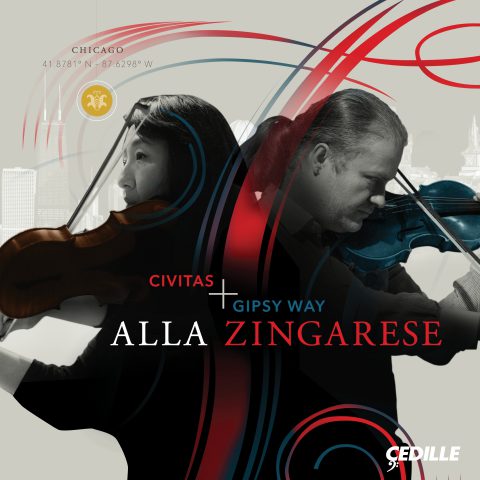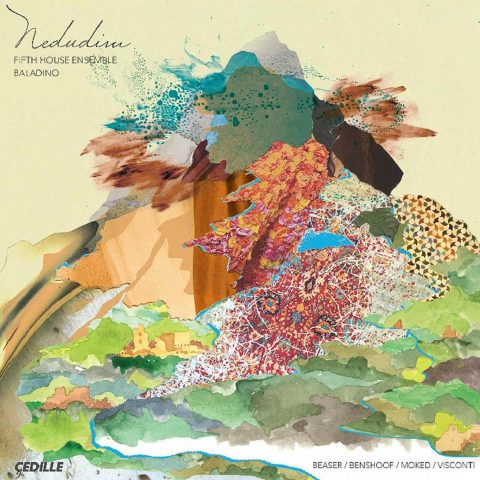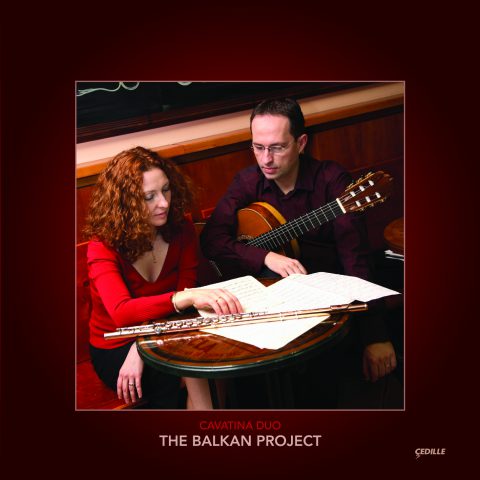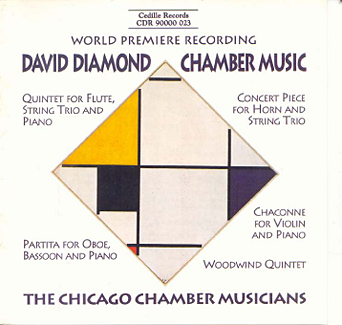Store
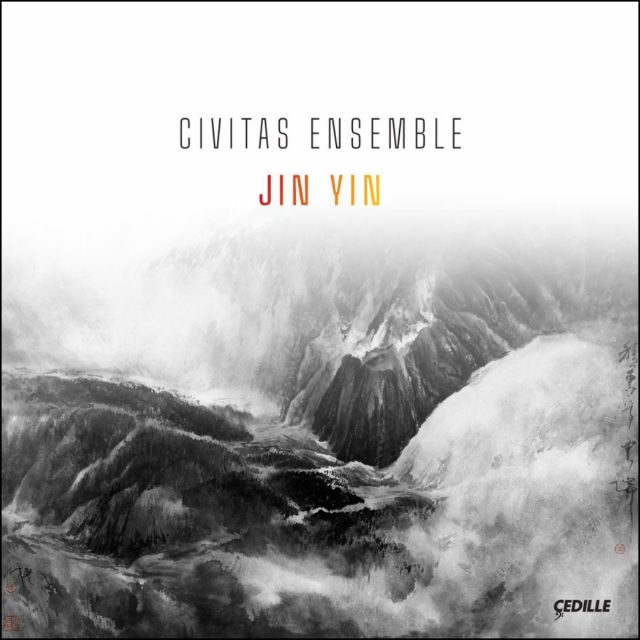
Chicago’s Civitas Ensemble presents a spectrum of new instrumental works by living Chinese composers, each with a unique perspective on Western and Far Eastern musical sensibilities. Spearheaded by Shanghai-born violinist Yuan-Qing Yu, a Civitas founding member and assistant concertmaster of the Chicago Symphony Orchestra, Jin Yin (“Golden Tone”) comprises world-premiere recordings of works by Yao Chen, Vivian Fung, and Lu Pei, plus specially made new arrangements of pieces from Zhou Long and Chen Yi.
First recordings include Yao Chen’s mystical, rhapsodic Emanations of Tara, named for a revered figure in Tibetan Buddhism and written expressly for the Civitas Ensemble; Vivian Fung’s Birdsong, a virtuosic piece for violin and piano that opens and closes with evocations of bird calls; and Lu Pei’s alternatively vigorous and lyrical Scenes Through Window, imbued with both American minimalist rhythms and South China folk traditions. Leading off the program, Zhou Long’s engaging Five Elements evokes metal, wood, water, fire, and earth, while Chen Yi’s serene, ethereal Night Thoughts was inspired by a Tang Dynasty poem. Both receive their first recordings in the composers’ own arrangements made specifically for the Civitas Ensemble.
The Civitas Ensemble named their album for the Chinese phrase meaning “Golden Tone” because they treasure these works for their clarity of musical expression.
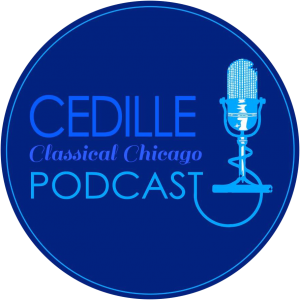
Listen to Jim Ginsburg’s interview
with Yuan-Qing Yu on Cedille’s
Classical Chicago Podcast
Preview Excerpts
ZHOU LONG
Five Elements
CHEN YI
LU PEI
VIVIAN FUNG
YAO CHEN
Emanations of Tara
Artists
1: Yihan Chen, pipa; Cynthia Yeh, percussion; Emma
Gerstein, flute and piccolo
7: with Emma Gerstein, flute
9: Yihan Chen, pipa
Program Notes
Download Album BookletJin Yin
Notes by Various
FIVE ELEMENTS by Zhou Long
The Five Elements (called “wu xing” in Chinese) are metal, wood, water, fire, and earth, held by the ancients to compose the physical universe and later used in traditional Chinese medicine to explain various physiological and pathological phenomena. In my five-movement composition, Five Elements, each of these elements is represented in the specific movements. The Five Elements are also known as The Five Movements (wu yun). They define the various stages of transformation in the recurring natural cycles of seasonal change, growth and decay, shifting climatic conditions, sounds, flavors, emotions, and human physiology. Each energy is associated with the natural element that most closely resembles its function and character, and they take their names from these elements. Like yin and yang, the Five Elemental Energies maintain their internal harmony through a system of mutual checks and balances known as “creative” and “control” cycles. Both of these cycles, which counteract and balance one another, are in constant operation, maintaining the dynamic fields of polar forces required to move and transform energies.
The first movement is Metal, which is a refined extract of Earth forged by Fire. The sound of forged iron is echoed by the striking chord on pipa, which creates distance in sonority. Percussion and pipa extend the flowing texture on wind and stringed instruments. These symbolize the image of extraction and refinement. The second movement is Wood. It symbolizes spring, and generates a strong and healthy cycle by water. Percussive rhythm on wooden percussion instruments and pizzicato on strings run through this movement as the creative energy of “spring fever.” It is associated with vigor and youth, growth and development.
The third movement is called Water, which is a highly concentrated element containing great potential power awaiting release. It is the element of energy associated with winter. The extensive texture and broad doubling melodies build a cool color tone which stays still. The fourth movement is Fire. Just as spring develops naturally into summer, the aggressive creative energy of Wood matures into the flourishing “full yang” energy of Fire. This movement contains consistent rhythmic drumming with energetic figures played by the ensemble. The last movement is Earth. The music is grounded on a peaceful open space, touched on lightly in a vast tempo, which transforms all elements into a perfect balance.
The version of Five Elements for flute/piccolo, clarinet, percussion, pipa, violin, and violoncello was Commissioned by the Chinese Fine Arts Society in 2014 for Forces of Nature, written for and premiered by Civitas Ensemble: Five Elements was made possible by a National Endowment for the Arts grant for the Chinese Fine Arts Society’s 30th Anniversary Season and dedicated to the memory of its founder, Barbara Tiao.
NIGHT THOUGHTS (2004/2019) by Chen Yi
Co-commissioned by the Virginia Arts Festival, Chamber Music Society of Lincoln Center, La Jolla SummerFest, and Chamber Music Northwest in Portland, OR, and supported by Meet The Composer’s Commissioning/USA program, my trio, Night Thoughts, is a lyrical tone poem originally scored for flute, cello, and piano and premiered on April 28, 2004 by Deborah Cross, Keith Robinson, and Andre-Michel Schub at the Virginia Arts Festival. I got the inspiration for the music from the ancient Chinese poem, Night Thoughts, written by the great poet, Li Bai, during the Tang Dynasty (618–907).
On couch bright moon shone,
Thought frost on ground foamed,
Raised head facing bright moon,
Lowered head dreaming my home.
(English translation by Chen Yi)
The atmosphere is serene and spatial, and the feeling is full of loneliness and nostalgia. The three instruments sometimes interact in moving-cluster-like groups, sometimes are spread out in a wide spectral range. The sonority is quietly shimmering or ethereal. I adapted the trio for violin, cello, and piano in 2019 for piano trio for my friend Yuan-Qing Yu and her Civitas Ensemble in Chicago. The new version was premiered excellently by Yuan-Qing Yu, Kenneth Olsen, and Winston Choi on July 23, 2019.
The work is dedicated to Ms. Heather Hitchen, President of Meet The Composer, for her hard work and strong support of living composers and new music creation in America.
SCENES THROUGH WINDOW by LU Pei
The inspiration for Scenes Through Window came when I was listening to rap music on my car radio while driving in Chicago in 2004. The American Composers Forum had commissioned me to write a piece years before, and I had been searching for inspiration since that time. As I listened to the rap songs, I became intrigued with the idea of combining rap’s repetition with Chinese folk music elements. While the impressionistic thematic materials of Scenes Through Window may draw parallels to American popular music, the work is, in fact, strongly influenced by folk music from the ethnic minority groups in Southern China. I was inspired, particularly, by the manner in which these groups play and dance with their music during festivals. Once I settled on this theme, the composing process flourished. The title, Scenes Through Window, came from personal experience. Some years ago, I watched and enjoyed the beautiful scenery through a window at my friend’s house on a mountaintop in Indiana. Scenes Through Window was originally composed for erhu, pipa, and piano trio and was premiered in Washington D.C. in 2007. The Washington Post described it as “extremely smart, colorful, delectable and kinetic.” Scenes Through Window was underwritten by the American Composers Forum in 2000 with funds provided by the Jerome Foundation. I made this version for flute, clarinet in B, and piano trio in 2016 when I was asked to submit a piece for a European ensemble’s concert at Shanghai Contemporary Music Week by the director, Professor Wen.
BIRD SONG FOR VIOLIN AND PIANO by Vivian Fung
Birdsong (2012) stems from a chance encounter with violinist Kristin Lee, who had previously been one of my undergraduate theory students back when I was teaching at the Juilliard School. Attending one of her recitals several years later, I was blown away by her playing, and Kristin and I immediately agreed to form a collaboration. That collaboration initially gave rise to my 2010 Violin Concerto (which garnered a JUNO Award in 2013), and Birdsong followed a couple of years later. The work showcases the virtuosity of both piano and violin, with quick runs, intense rhythmic passages, and exploration of improvisational moments. The title refers to the birdcalls of the opening and closing passages, as well as the general rhapsodic nature of the violin in this piece. The work is dedicated to the memory of Julian Rodescu, who had been Artistic Director of Astral Artists in Philadelphia and Kristin’s mentor and advisor, as well as a mentor to me during the writing of my Violin Concerto. The ending, in particular, is a paean to Julian’s memory and spirit, a nostalgic tribute to a man who had a positive influence on many musicians. Birdsong was commissioned by the Delaware Chamber Music Festival through the DeRosa Family Fund. It was premiere on June 22, 2012 in Wilmington, Delaware, with Kristin Lee, violin, and Conor Hanick, piano.
EMANATIONS OF TARA note by Dan Albertson
Written on a commission from the Fromm Music Foundation at Harvard University in 2014, Yao Chen’s Emanations of Tara dates from a transitional period in the composer’s career while reflecting several of his recurring themes. After graduating from the University of Chicago, plus a period spent teaching in the USA, Yao Chen returned to China to embark on a dual career as a composer and teacher. Among the first pieces he wrote after his homecoming, Tara is for five players but with a duration and subject matter far beyond the constraints of the medium. It was written very much with American performers — specifically, the Civitas Ensemble — in mind. Since quite early in his career, Yao Chen has written a small but important series of works in which Chinese and western instruments are combined, as well as works for Chinese instruments alone. These pieces, far from concerning themselves with questions of the exotic or notions of purity, are rather catalysts for the exploration of sonority, shared or otherwise, and the existence or coexistence of varied means of sound production. Tara is another entry in this series, with the pipa taking the role less of a concertante soloist and more of a committed collaborator with the other four players: clarinet doubling bass clarinet and a small prayer bowl, violin, cello, and piano doubling a big prayer bowl. It is a rhapsodic work in which all five instrumentalists form an indissoluble if variable unit, five questing musicians taking themselves, as well as listeners, on a journey into the unknown.
Tara embodies Yao Chen’s ongoing preoccupation with spirituality in music and the search for transcendence, both internally and externally. While taking as inspiration the composer’s visit to Tibet, and many-colored Thangka paintings and statues of the goddess Tara in particular, the piece is not in any way illustrative or narrative. It is, rather, an abstract and extended meditation on just a few of the many qualities of Tara, the female bodhisattva of compassion and virtue, she who rescues all living beings from the eternal cycle of life, death, and rebirth known as samsara, and guides her followers toward spiritual enlightenment.
Is knowing this background essential to understanding the music? Yes and no. Yao Chen is not a composer who seeks readymade solutions. This music is rich enough, and flexible enough, to allow the listener to imagine any number of interpretations. This ambiguity is essential to the message and what Tara requires above all is a profound level of engagement to make the most of its innumerable plays of light and shadow, its detours and forays into worlds unknown. Tara is free-flowing and solemn, though at times mercurial, and its predominant mood is one of languor, an awareness of existential time without any sense of urgency or pulse. Far from aimless, it is totally willing to linger and meander, and is best approached with a willingness to be surprised. Even without visual reinforcement, it easily transports listeners somewhere else, somewhere more idealized if less real, but precisely for this lack of reality, stronger and dearer.
Album Details
PRODUCER James Ginsburg
ENGINEER Bill Maylone
STEINWAY PIANO TECHNICIAN Ken Orgel
GRAPHIC DESIGN Bark Design
COVER ART Lampo Leong, Floating Clouds over Snowy Mountains (2012)
RECORDED
Emanations of Tara and Five Elements: February 27 and March 1–2, 2018 in Anne and Howard Gottlieb Hall at the Merit School of Music, Chicago, IL
Night Thoughts, Bird Song, and Scenes Through Window: August 29–30, 2019 at the Reva and David Logan Center for the Arts at the University of Chicago
PUBLISHERS
Emanations of Tara © 2014 Yaochen
Five Elements © 2014 Oxford University Press
Night Thoughts © 2004/2019 Chen Yi
Bird Song © 2012 Bill Holab Music
Scenes Through Window © 2005/2016 LU Pei (BMI)
This album is made possible by the generous support of Jia Zhao and Hongyi Chen and the Board of Directors of Cedille Chicago, NFP
©2020 Cedille Records/Cedille Chicago
CDR 90000 193
